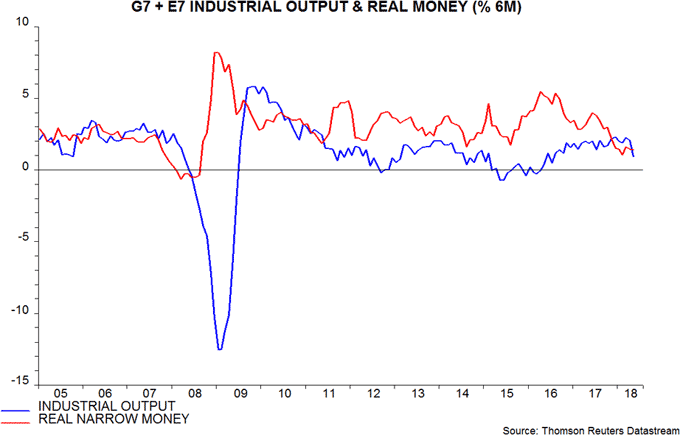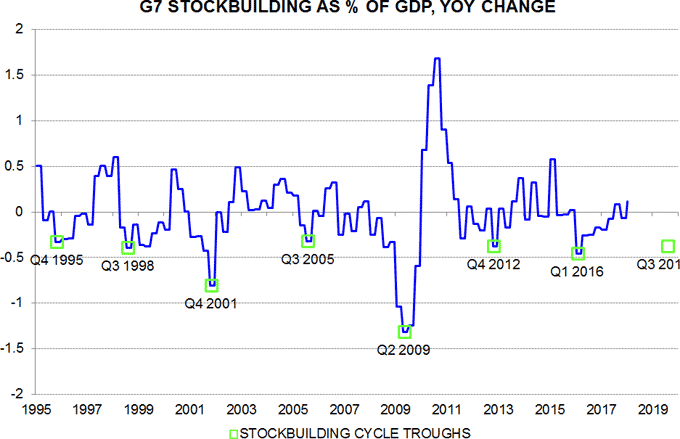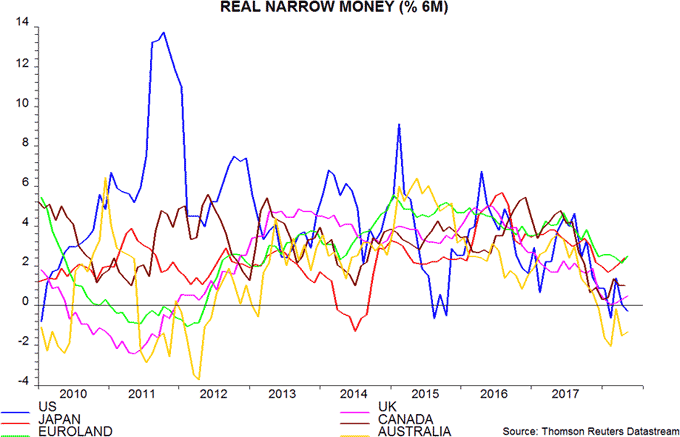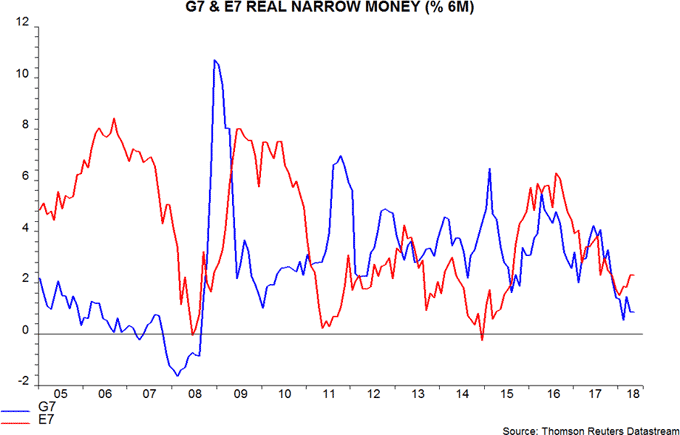Entries from July 1, 2018 - July 31, 2018
OECD leading indicator preview: further weakness
The central expectation here, based on monetary trends, is that global economic momentum will continue to weaken into the fourth quarter of 2018 before reviving slightly into early 2019 – see previous post. The OECD’s composite leading indicators, which in most cases exclude money, are giving stronger support for the forecast of a near-term further economic slowdown.
The OECD will release June data for its indicators on 8 August but most of the component information is already available, allowing an independent calculation. The G7 indicator is estimated to have fallen further in June, with revisions likely to magnify the scale / speed of the decline from a January 2018 peak – see first chart. The indicator is expressed in trend-adjusted form, i.e. the recent fall implies below-trend economic growth.

The decline in the G7 indicator was initially driven by European countries and Japan, with the US indicator continuing to rise. This raised the possibility that non-US weakness would prove temporary as US acceleration boosted global demand – the consensus view when economic data started to disappoint in early 2018.
Monetary trends, however, suggested that convergence would occur by the US losing momentum rather than a pick-up in the rest of the G7. The latest leading indicator estimates are consistent with this expectation, with the US indicator also now falling and no let-up in the declines in Europe / Japan – second chart.

The third chart shows a “global” indicator that combines data for the G7 and seven large emerging economies (the “E7”) while “adding back” an estimate of trend industrial output growth. Six-month growth of this indicator peaked in December 2017 ahead of a March 2018 peak in G7 plus E7 six-month output expansion. It continued to decline in June, consistent with a further loss of output momentum through the third quarter, as suggested by monetary trends.

Based on the monetary forecast that economic momentum will bottom in the fourth quarter, one- and six-month changes in the G7 plus E7 leading indicator may stabilise during the third quarter.
No monetary case for UK rate hike
UK monetary trends are showing signs of recovery but remain weak, arguing against the rate hike that the Monetary Policy Committee is expected to deliver this week.
As usual, the focus here is on “non-financial” broad (M4) and narrow (M1) monetary aggregates, comprising money holdings of households and private non-financial businesses. The Bank of England’s M4ex measure additionally includes money held by non-bank financial corporations (excluding intermediaries) but such holdings are volatile and uninformative about future spending on goods and services*.
Annual non-financial M4 growth was 3.1% in June, which compares with a recent low of 3.0% in April and a peak of 6.8% in September 2016. Annual non-financial M1 growth fell further to 4.4% in June, a six-year low and down from 10.1% in September 2016 – see first chart.

As the chart shows, the collapse in money growth since 2016 has been reflected in a significant slowdown in nominal GDP, annual expansion of which is currently estimated by the Office for National Statistics to have fallen to only 2.7% in the first quarter of 2018.
Three-month growth of the two aggregates recovered during the second quarter, suggesting a stabilisation or modest revival in the annual rates of expansion – second chart. A significant pick-up, however, would be required to warrant concern that monetary conditions are too loose for achievement of the inflation target over the medium term.

Current monetary trends, indeed, argue that an inflation undershoot is more likely. The velocity of non-financial M4 – i.e. the ratio of nominal GDP to the aggregate – has fallen at an average rate of 0.7% per annum (pa) since end-2009, compared with a reduction of 3.0% pa over the prior decade. Assuming a continued decline of 0.7% pa, current annual growth of non-financial M4 of 3.1% in June, if sustained, would result in a 2.4% pa rate of increase of nominal GDP. This would imply an inflation undershoot unless potential economic expansion is well below 1% pa.
The MPC has a long tradition of ignoring monetary trends and continues to make serial policy mistakes as a result. It failed to lean against monetary buoyancy in the mid-2000s, prolonging and magnifying the credit bubble. It was slow to launch QE after the bubble burst and monetary trends stagnated.
After an initial recovery, money growth fell back in 2010 but the Bank of England proceeded to wind down the special liquidity scheme, which had provided significant support for bank balance sheet expansion, thereby exacerbating monetary weakness and contributing to the 2011-12 economic slowdown and double-dip scare.
The most recent mistake was to cut rates and launch additional QE in August 2016 despite strong money growth, which signalled that the economy was likely to continue to expand despite the negative shock of the EU referendum result. This unnecessary policy easing magnified sterling weakness and associated upward pressure on import prices and inflation.
The MPC now appears poised to make the opposite mistake. Three-month growth of the money measures fell sharply immediately after the November 2017 rate hike – second chart. A similar response to an August 2018 increase could result in annual rates of expansion declining to dangerously low levels. Why run this risk? The MPC should skip policy action this week and make a November rate increase conditional on a further recovery in monetary trends.
*M4ex is giving a similar message to the non-financial monetary aggregates currently.
Euroland money trends steady, Italy / Greece stronger
The “surprise” weakening of Euroland economic growth in the first half of 2018 was foreshadowed by a monetary slowdown in late 2017. Monetary trends have stabilised since early 2018, suggesting that economic expansion will continue at around its recent pace through early 2019 – GDP may rise at a 1.25-1.5% annualised rate, below ECB and consensus forecasts of 1.75-2.0%. Country narrow money details show weakness in France, surprising resilience in Italy and growing strength in Greece.
As usual, the focus here is on non-financial monetary aggregates, comprising holdings of households and non-financial corporations (NFCs). Non-financial M1 and non-financial M3 rose by 0.3% and 0.4% respectively between May and June. Annual growth of non-financial M1 edged down to 7.3% but remained above a March low of 7.2%. Annual non-financial M3 growth rose to 4.0%, a five-month high and up from 3.4% in March – see first chart.

Six-month growth rates of the aggregates expressed in real terms (i.e. deflated by consumer prices) recovered further to their highest levels since November. They remain, however, lower than over 2015-17 and similar to 2013-14, when GDP growth was running at about 1.5% per annum* – second chart.

Country-level narrow money trends suggest a relatively pessimistic outlook for the French economy: six-month growth of real non-financial M1 deposits fell to a five-year low in June – third chart

Recent weakness, moreover, reflects a stagnation in corporate real money holdings, which appears at odds with hopes that President Macron’s economic reforms would boost business confidence and expansion plans – fourth chart.

Growth of real non-financial M1 deposits in Italy, by contrast, rebounded strongly in June, suggesting that confidence and spending intentions are holding up despite the risk of a government / EU showdown over fiscal policy and an associated widening of the Italian / German yield spread.
Greek real non-financial M1 growth, meanwhile, reached its highest level since 2016, with corporate holdings surging – fifth chart. The strength in 2015-16 was artificial – it reflected a boost to overnight deposits from maturing time deposits but money was trapped in the banking system by cash withdrawal limits and capital controls. These have been relaxed significantly in 2018, while broad as well as narrow money has accelerated.

*Annualised rise of 1.4% between second quarter of 2013 and fourth quarter of 2014.
Global monetary update: US slowdown ahead?
Global narrow money trends have stabilised since early 2018 but continue to signal a weak economic outlook. US narrow money has stagnated in real (i.e. inflation-adjusted) terms, suggesting that the US economy will lose momentum during the second half of the year, a forecast supported by a recent fall in the OECD’s US composite leading indicator (which excludes money). An upside risk to the gloomy global assessment here is a revival in Chinese money growth in response to recent policy easing. Such a revival, however, would be unlikely to be reflected in economic data until end-2018 at the earliest.
Six-month growth of real narrow money in the G7 economies and seven large emerging economies (the “E7”) is estimated to have risen slightly in June, based on monetary data covering about two-thirds of the aggregate and full consumer price information. If confirmed, the June reading would be the highest since November 2017 – see first chart.

The fall in real narrow money growth between June 2017 and February 2018 is now being reflected in a slowdown in industrial output, six-month growth of which peaked in March and fell sharply in May; partial data suggest a stabilisation in June*. With real money growth recovering since February, industrial output momentum may bottom around November 2018 and revive into early 2019, allowing for a typical nine-month lead.
Global real narrow money growth, however, remains below its range between September 2008 and November 2017, suggesting weak economic expansion by the standards of recent years.
Real narrow money growth has recovered in Japan and, to a much lesser extent, China but monthly US data remain weak – second chart. The US narrow aggregate tracked here, M1A**, was unchanged in real terms (i.e. relative to consumer prices) between August 2017 and June 2018.

A previous post noted that US non-financial M1, which is available quarterly, outpaced M1 and M1A in early 2018, helping to explain recent economic strength – third chart. Divergences, however, are usually temporary and this aggregate probably slowed significantly in the second quarter – data, unfortunately, will not be available until early September.

The suggestion that the US economy will lose momentum during the second half is supported by the OECD’s composite leading indicator, which is estimated to have fallen in June, with earlier data revised weaker – fourth chart. The indicator is expressed in trend-adjusted form, i.e. the recent decline implies a switch from above- to below-trend expansion.

Six of the seven indicator components are now falling relative to trend, i.e. housing starts, consumer sentiment, average weekly hours worked in manufacturing, the ISM manufacturing purchasing managers’ index, share prices and the slope of the yield curve. The sole rising component is new orders for durable goods.
According to the revised estimates, the US indicator peaked in March, which compares with a November 2017 peak in the companion Euroland leading indicator. Euroland economic news started to surprise negatively from March 2018, four months after the leading indicator peak. US economic surprises have recently moved from positive to neutral and may be about to turn negative.
With G7 monetary policies tightening in terms of both rates and the pace of QE, any near-term pick-up in global real narrow money growth is likely to depend on a revival in China. As noted, Chinese monetary momentum appears to have bottomed and the historical relationship with the change in the two-year government bond yield, inverted, suggests a recovery ahead – fifth chart. The impact of policy stimulus, however, could be offset by a market-driven tightening of credit conditions and / or capital outflows.

*Output series adjusted to exclude large May fall in Brazil due to truckers’ strike.
**M1A = currency plus demand deposits.
Is the stockbuilding cycle peaking?
The US ISM manufacturing new orders index – an important gauge of US / global industrial momentum – fell back between December 2017 and April 2018 but rebounded in May / June. This recovery has been cited as evidence in favour of the consensus view that the global economic slowdown since early 2018 represents a temporary “soft patch”. The judgement here, by contrast, is that the ISM new orders increase will prove to be a “head-fake” caused by rapid inventory accumulation as the three- to five-year stockbuilding cycle reaches a peak.
Conceptually, new orders from customers received by ISM firms can be divided into trend and transitory components, reflecting respectively final demand and customers’ efforts to adjust their inventories to a desired level. The transitory component, by definition, is high at the peak of the stockbuilding cycle. New orders subsequently move back to trend and then below it as the cycle downswing develops.
The ISM survey does not distinguish between these two sources of order flow. The transitory component, however, should be related to the customer inventories index, which measures whether stock levels are judged to be too high or too low. A low level of the index should be associated with high customer orders related to stockbuilding. A low index, that is, should imply strong transitory demand and a future decline in aggregate new orders as this fades.
The customer inventories index fell below 40 in May / June versus an average of 45.8 between its inception at the start of 1997 and end-2017 – see first chart. The index has been below 40 in 22 previous months historically. The average change in the new orders index over the subsequent six months was -3.6 points. Such a fall would more than offset the May / June rise.

The suggestion that ISM new orders index will resume a decline over coming months is supported by the Conference Board CEO confidence survey for the second quarter, conducted between mid-May and mid-June. Expectations for manufacturing business conditions in six months’ time correlate with and sometimes lead the ISM new orders index, and fell to a seven-quarter low – second chart.

Stockbuilding strength may have been exaggerated by firms boosting inventories of items at risk of tariff-related price increases or supply disruption. The ISM imports index rose sharply in June and is far above its long-term average. Front-loading of orders and production due to tariffs, that is, may have supported industrial activity at the likely expense of greater weakness later in 2018 as the stockbuilding cycle turns down.
A "monetarist" perspective on current equity markets
Global monetary trends have stabilised but remain weak, suggesting slow economic growth and an unpromising backdrop for equities and other risk assets, warranting maintaining a cautious investment stance.
Our key forecasting indicator is the six-month growth rate of real (i.e. inflation-adjusted) narrow money in the G7 countries and seven large emerging economies (the “E7”)*. Real money growth peaked most recently in June 2017, falling to a nine-year low in February 2018. Allowing for the typical nine-month lead, this suggested that global economic growth would peak around March 2018 and fade into the second half of the year.
Shorter-term leading indicators began to confirm the monetary forecast in early 2018. The global manufacturing purchasing managers’ index, for example, peaked in December 2017, falling to an 11-month low in June. A slowdown is now also evident in G7 plus E7 industrial output data, with six-month growth declining sharply in May** – see first chart.

A further significant development in late 2017 was that six-month growth of G7 plus E7 real narrow money crossed beneath industrial output expansion. Since 1970, global equities, as measured by the MSCI World index in US dollar terms, have underperformed US dollar cash by 7.2% per annum on average when real money has lagged industrial output. Equities started the year strongly but MSCI World lost 4.3% between end-January and end-June, resulting in a first-half return of only 0.8%.
Monetary trends, thankfully, stabilised in the second quarter: G7 plus E7 real narrow money growth rebounded in March and held above the February low in April / May. It remains, however, weaker than over 2009-17. The suggestion is that global economic momentum will bottom out in late 2018 but without much of a rebound subsequently. Consensus growth forecasts, in our view, remain too high.
We do not rule out a more significant recovery in real money growth. China has started to ease monetary policy but the impact could be offset by tightening credit market conditions and capital outflows. The US tax cuts may still be filtering through to spending intentions and money demand but any boost may be outweighed by ongoing Fed policy tightening. Escalating trade tensions, meanwhile, may cause a downward revision to business investment plans, a development that would probably be associated with a fall in corporate money growth.
A cautious view of economic and investment prospects, therefore, will be maintained pending more convincing evidence of a change in monetary trends. A monetary relapse, of course, would argue for a further move towards defence.
Our caution is also informed by longer-term cycle analysis, although this plays a secondary role to monetary signals in our forecasting process. Commentators frequently refer to “the” business cycle but there are, in fact, several cycles of different lengths that interact to produce observed economic fluctuations. The three key cycles are the 3-5 year stockbuilding or inventory cycle, the 7-11 year business investment cycle and the 15-25 year housebuilding cycle. Cycle lengths are measured from peak to peak or trough to trough.
The housebuilding cycle bottomed in 2009 so another trough is not scheduled until the mid 2020s at the earliest. The business investment and stockbuilding cycles, however, bottomed most recently in 2009 and 2016 respectively. Downswings in the two cycles, therefore, are scheduled to occur in 2019-20. In the event that the downswings are synchronised, a recession will be likely. The last business investment / stockbuilding recession occurred in 2001. Such recessions are usually – though not always – less severe than those involving downswings in the housebuilding cycle.
The cycle analysis provides a longer-term framework for assessing monetary signals. The current message is that, if global money trends were to recover, the implied subsequent pick-up in economic growth would probably be modest and short-lived. The current position of the business investment and stockbuilding cycles, in other words, argues for downplaying a positive monetary signal while according strong significance to a negative one.
A 2019-20 global recession is not, it should be emphasised, the current central forecast here. Such a scenario would need to be confirmed by the six-month change in global real narrow money turning negative, as it has before every previous recession since the 1970s (at least).
Our analysis suggests that the pattern of market returns is strongly correlated with the stockbuilding cycle, whether or not this cycle is aligned with the other cycles. Specifically, the 18 months following a trough in the stockbuilding cycle is usually a “risk-on” phase characterised by strong performance of equities, credit and commodities, with cyclical sectors outperforming defensives. These trends reverse in the 18-month lead-in to the next trough.
While the stockbuilding cycle can stretch to 5 years, the average historical length has been about 3.5 years. Based on the contribution of stockbuilding to annual G7 GDP growth, we judge that the cycle last bottomed in early 2016, implying that the next trough could occur in the second half of 2019 – second chart. If so, the 18-month negative window for markets may already have opened.

Recent equity market sectoral performance is consistent with an economic slowdown. The MSCI World cyclical sectors index rose strongly in early 2018 but fell by 2.9% between end-February and end-June, versus a 1.9% rise in the defensive sectors index over the same period. The weakness in the cyclical index has been driven by financials, materials and industrials, with information technology and consumer discretionary remaining strong until late in the second quarter – third chart. Energy, utilities and health care have been the best-performing defensive sectors.

Monetary trends show a similar pattern of stabilisation but no significant recovery across most major developed economies. The six-month rate of change of real narrow money is above-average in Japan and Euroland and weakest in Australia – fourth chart.

In Euroland, we are on the alert for a further slowdown in Italian real narrow money, reflecting a widening of yield spreads following the formation of an EU-sceptic populist government – fifth chart. The ECB’s plans to phase out bond purchases by end-2018 could act as a drag on area-wide money growth, although the central bank has also signalled that rates will be held at their current negative level through September 2019, at least.

UK monetary trends remain weak and are at risk from a mooted August rate increase. Money measures slowed sharply immediately after the November 2017 hike.
Monetary policy may offer greater support for money trends in Japan, although Bank of Japan bond purchases continue to run well below the expected ¥80 trillion per annum pace. Real money growth has been boosted recently by a slowdown in inflation, although this may prove temporary.
Emerging equity markets typically underperform developed markets during the downswing phase of the stockbuilding cycle. Relative monetary trends, however, are currently supportive, with E7 six-month real narrow money growth slightly above the G7 level – sixth chart. With currency weakness causing policy tightening and higher inflation in a number of EM economies, the sustainability of this positive divergence is in doubt.

*Narrow money = currency in circulation plus demand deposits and close substitutes. Broad money = narrow money plus time deposits, notice accounts, repos and bank securities. Precise definitions vary by country. Narrow money has been more reliable than broad money for forecasting purposes historically and is consequently emphasised in the analysis here. E7 defined here as Brazil, Russia, India, China, Korea, Mexico and Taiwan.
**The May fall was exaggerated by a fire at a US auto parts plant and a truckers’ strike in Brazil.

